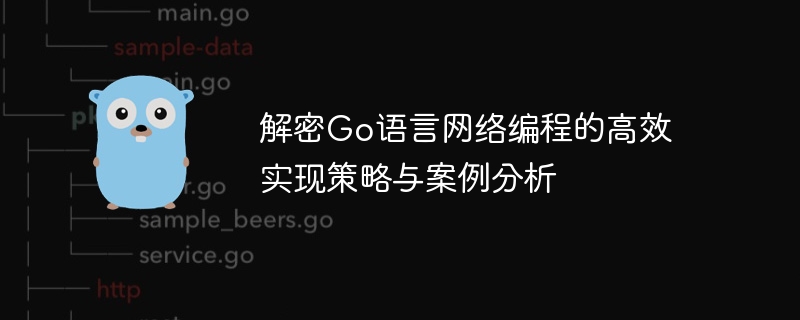

Decrypting the efficient implementation strategies and case analysis of Go language network programming
With the rapid development of the Internet and With the continuous emergence of diverse needs, network programming is becoming more and more important. As a modern programming language, Go language is increasingly favored by developers for its excellent concurrency capabilities and concise syntax. This article will discuss efficient implementation strategies for Go language network programming and give specific code examples through case analysis.
2.1 Using Goroutine
The built-in Goroutine mechanism of Go language provides great convenience for concurrent programming. In network programming, each connection can be processed as a Goroutine to achieve high concurrency network services. In the code example, we can use the go keyword to start a Goroutine to process each connection and perform the corresponding network operations.
2.2 Using Channel
Channel in Go language can realize communication between threads and can be used to synchronize and transfer data. In network programming, we can use Channel to perform asynchronous operations, such as transferring data between multiple Goroutines, synchronizing data, etc. In the case study, we can see how to use Channel to achieve data transmission and synchronization.
2.3 Using the standard library
The standard library of Go language provides a wealth of network programming-related packages, such as the net package for network communication, http package is used for HTTP service, websocket package is used for WebSocket communication, etc. These standard libraries provide many advanced functions and tools, which can greatly simplify the implementation of network programming. In the case study, we will show how to use these standard libraries to implement network services.
Below we use a specific case to analyze how to use Go language to achieve efficient network programming.
Case: Simple HTTP server
The following is a code example of a simple HTTP server:
package main
import (
"fmt"
"net/http"
)
func handleRequest(w http.ResponseWriter, r *http.Request) {
fmt.Fprintf(w, "Hello, world!")
}
func main() {
http.HandleFunc("/", handleRequest)
http.ListenAndServe(":8080", nil)
}This code example implements a simple HTTP server, which can be The local port 8080 listens for HTTP requests and returns "Hello, world!" as a response. In the handleRequest function, we use http.ResponseWriter to send a response to the client. In http.Request we can obtain the client's request information. http.HandleFuncUsed to specify the request processing function. http.ListenAndServe is used to start the HTTP server.
Through this simple case, we can see that the built-in network programming support of the Go language is very powerful and concise, making it very easy to implement a basic HTTP server.
This article introduces the efficient implementation strategy of Go language network programming and gives specific code examples through case analysis. We can see that the Go language provides powerful language features and standard library support, making network programming simple and efficient. For developers, mastering these implementation strategies and techniques will help improve the efficiency and quality of network programming.
(Note: The above code examples are for reference only. In actual use, they need to be adapted and modified based on specific needs.)
The above is the detailed content of Implementation strategies and case studies of Go language network programming: efficient decryption. For more information, please follow other related articles on the PHP Chinese website!
 Usage of Type keyword in Go
Usage of Type keyword in Go
 How to implement linked list in go
How to implement linked list in go
 What are the Go language programming software?
What are the Go language programming software?
 Zero-based Java self-study tutorial
Zero-based Java self-study tutorial
 How to learn go language from 0 basics
How to learn go language from 0 basics
 What are the methods to implement operator overloading in Go language?
What are the methods to implement operator overloading in Go language?
 What are the operators in Go language?
What are the operators in Go language?
 What do computer software systems include?
What do computer software systems include?




